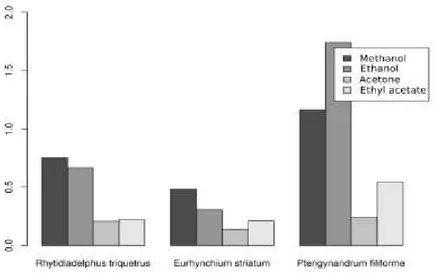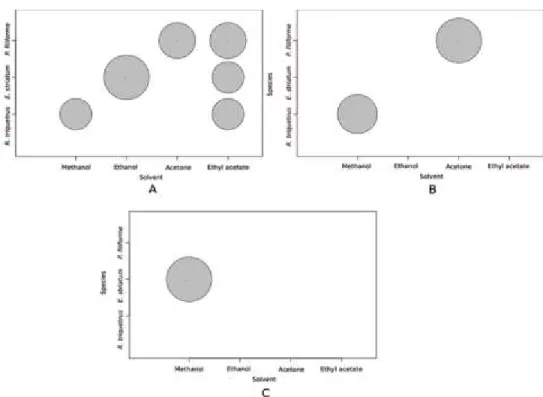Volume 27, Number 2, Pages 17-22 (2018) DOI: 10.1501/commuc_0000000194 ISSN 1303-6025
http://communications.science.ankara.edu.tr/index.php?series=C
Received by the editors: July 25, 2018; Accepted: September 10, 2018. Key word and phrases: Antimicrobial activity, moss, disk diffusion method
© 2018 Ankara University Communications Faculty of Sciences University of Ankara Series C: Biology
ANTIMICROBIAL ACTIVITIES OF SOME BRYOPHYTES IN TURKEY ŞENOL ALAN, FERUDUN KOÇER, AND GÜRAY UYAR
Abstract. Bryophytes spreading throughout the world in all geographical and climatic conditions are one of the most important parts of the ecosystem. Some species of bryophytes are used in traditional medicine thanks to their strong antimicrobial and biological effects. Bryophytes contain many phenolic compounds being natural antioxidants, in addition it has been used for prevention and treatment of cardiovascular and oncological diseases. Thus the Bryophytes allow us new opportunities to discover new antimicrobial agents as well as anticarcinogenic. In this study, antimicrobial activities of three moss species [Rhytidiadelphus triquetrus (Hedw.) Warnst.,
Eurhynchium striatum W. P. Schimper, Pterigynandrum filiforme Hedw.] which distributes in
Western Black Sea Region were investigated by using four different solvent and Kirby Bauer disc diffusion technique. The effects of extracts from bryophytes on strains of Escherichia coli T. Escherich ATCC-8739, Staphylococcus aureus Rosenbach ATCC-6538, Bacillus subtilis Ehrenberg ATCC-14028, Pseudomonas aeruginosa (Schroeter) Migula ATCC-9027 were investigated. It is observed that the strain of Bacillus subtilis ATCC-14028 was sensitive to the extracts. However, it wasn’t detected any effect on Escherichia coli strain ATCC-8739 and it was determined that this strain was the most resistant strain against the extracts. The biggest inhibition zone was yielded with methanol in E. striatum against S. aureus. The inhibition zone of P.
aeruginosa was obtained only with extracts prepared from R. triquetrus and P. filiforme.
1. Introduction
Bryophytes, including liverworts (Marchantiophyta), hornwort (Anthocerotophyta) and mosses (Bryophyta), contain plants found in more humid or extreme habitats. Recent phylogenetic studies are shown that bryophytes contains about 19000 species [1] and the number of species which has been identified in Turkey so far is about 1000 [2].
Mosses are used as medicines in Indian culture thanks to their antimicrobial properties [3,4]. In addition, it have been used as diaper and sanitary napkin since they have high water holding capacity. It is also known that bacteria do not play a role in their decay, because they produce antimicrobial agents [5]. Therefore, mosses may be a suitable source of antimicrobial agents.
Today, mosses are used not only for medical purposes but also as indicator plants in environmental pollution studies [6,7]. It is also found that Bryophytes extracts were quite effective on Paenibacillus larvae which is known to cause American foulbrood in honeybees [8]. Moreover, it has increased the number of studies about antimicrobial activity of mosses in last two decade. Many studies have shown that many compound in mosses has antimicrobial activity [9,10].
The success rate against multiple antibiotic resistance is gradually decreasing in the treatment of infection. Since the rapid spreading of antibiotic resistance bacteria, it is needed that searching new antimicrobial agents. Therefore, isolation of new antibiotics from plants and usage of as alternative medicine is still continues to be important. Bryophytes are potential new antibiotic sources.
We aimed investigate antimicrobial activity of three mosses (Rhytidiadelphus triquetrus (Hedw.) Warnst., Eurhynchium striatum W. P. Schimper, Pterigynandrum filiforme Hedw.) using disc diffusion method in this study.
2. Material and Methods 2.1. Plant Material and Extract Preparation
Samples of R. triquetrus, E. striatum, P. filiforme were collected from Western Black Sea Region [11]. After the samples were dried at room temperature, they were washed with pure water and packaged as 5 g cartridges. Then dried samples were extracted with a Soxhlet apparatus. The extraction process was carried out for 6 hours using 400 ml solvent. It was used different solvents such as ethanol, methanol, acetone and ethyl acetate for every moss species in the extraction process. Obtained extracts were evaporated until remaining 2 ml of solvent at rotary evaporator. The temperature used in the process was setted according to boiling point of solvents. Prepared extractions were stored until use at +4 °C. Amount of total substance was also recorded by weighing of obtained extracts.
2.2. Determination of Antimicrobial Activity
Antimicrobial activity of extracts of 3 mosses were investigated with Kirby Bauer diffusion method by using Escherichia coli T. Escherich ATCC-8739, Staphylococcus aureus Rosenbach 6538, Bacillus subtilis Ehrenberg ATCC-14028, Pseudomonas aeruginosa (Schroeter) Migula ATCC-9027. Müeller-Hinton Agar was used for antimicrobial activity test. Bacterial strains which are inoculated
to Müeller-Hinton Broth were used for activation of the microorganisms [12,13]. Sterile empty Whatman papers in 6 mm diameter that were wetted with 20 μl extracts with the help of a micropipette were placed on broth plaques which bacteria was cultivated. This study was carried out in triplicate for each microorganism.
3. Results and Discussion
The amounts of substance obtained from extraction of three mosses with four different solvents were presented in Figure 1.
Figure 1. Amounts of substance which was obtained in the study.
Maximum amount of substance was yielded from P. filiforme with all solvents that were tested. On the other hand, it was seen that maximum amount of substance was obtained with ethanol. But when P. filiforme was excluded, the maximum amount of substance was obtained with methanol.
When considering of the results of antimicrobial activity obtained from antibiogram discs which prepared from three species, it is appeared that B. subtilis was the most sensitive bacteria to the extracts which were studied. While ethyl acetate extracts from all of three species were effective on this bacteria, the biggest inhibition zone was obtained with ethanol in E. striatum. P. filiforme which was the last moss species
investigated in the study created zone in same size with ethyl acetate and acetone (Figure 2).
The biggest inhibition zone was yielded with methanol in E. striatum against S. aureus. It was found that the extracts prepared with other species and solvents were ineffective over this microorganism (Figure 2).
The inhibition zone of P. aeruginosa was obtained only with extracts prepared from R. triquetrus and P. filiforme respectively with methanol and acetone. It was found that extract from P. filiforme with acetone had the biggest inhibition zone. It was also showed that mosses that were studied in this study were ineffective on E.coli (Figure 2).
Figure 2. Inhibition zones of extracts of three moss species prepared with various solvents against. B. subtilis (A), P. aeruginosa (B), S. aureus (C).
It was examined antimicrobial effect of three mosses on four different microorganisms in the study. Many studies have been conducted about antimicrobial activities of bryophytes recently. In the light of this results, it has been emphasized that bryophytes are effective on B. subtilis [1,3]. Thus, our results we obtained are consistent with the literature.
The last published study was reported that ethanolic extract of P. filiforme had antimicrobial activity on S. aureus and B. subtilis. In our study, we did not observe any inhibition with ethanolic extract of this species. This could be associated with the amount of starting material for extraction procedure. Since the amount of sample which was used for extraction wasn't given in the article, it is impossible evaluating of this hypothesis [14].
Methanolic extraction of E. striatum was presented significantly antimicrobial activity on S. aureus which is responsible for hospital infections. Results of obtained inhibition zones in this studyshowed the consistency with investigation of Uyar et al. [15]. Although many studies have emphasized that acetone extract of bryophytes have antimicrobial effect on gram-negative bacteria such as E. coli, we found that acetone extract of studied moss species were ineffective [16].
References
[1] A. Vanderpoorten and B. Goffinet, Introduction to bryophytes, ISBN: 1-107-37736-6, Cambridge University Press, 2009.
[2] A. Erdağ and H. Kürschner, A reference list of Turkish bryophytes. The state of knowledge from 1829 until 2017, Anatol. Bryol., 3, No. 2 (2017) 81-102. doi:10.26672/anatolianbryology.343242.
[3] V. Nikolajeva, L. Liepina, Z. Petrina, G. Krumina, M. Grube, and I. Muiznieks, Antibacterial activity of extracts from some bryophytes, Adv. Microbiol., 2, No. 03 (2012) 345.
[4] J.P. Frahm, Biologie der Moose, ISBN: 3-8274-0164-X, Springer, 2001.
[5] D.H. Richardson, The biology of mosses, ISBN: 0-470-27190-6, Halsted Press, 1981. [6] H. Çabuk, M.S. Kılıç, and M. Ören, Biomonitoring of polycyclic aromatic
hydrocarbons in urban and industrial environments of the Western Black Sea Region, Turkey, Environ. Monit. Assess., 186, No. 3 (2014) 1515-1524.
[7] Z. Varela, J.A. Fernández, C. Real, A. Carballeira, and J.R. Aboal, Influence of the physicochemical characteristics of pollutants on their uptake in moss, Atmos. Environ., 102, (2015) 130-135.
[8] E. Sevim, Y. Baş, G. Celik, M. Pınarbaş, A. Bozdeveci, T. Özdemir, R. Akpınar, N. Yayli, and Ş.A. Karaoğlu, Antibacterial activity of bryophyte species against Paenibacillus larvae isolates, Turk. J. Vet. Anim. Sci., 41, No. 4 (2017) 521-531. [9] M. Vollár, A. Gyovai, P. Szűcs, I. Zupkó, M. Marschall, B. Csupor-Löffler, P. Bérdi,
A. Vecsernyés, A. Csorba, and E. Liktor-Busa, Antiproliferative and Antimicrobial Activities of Selected Bryophytes, Molecules, 23, No. 7 (2018) 1520.
[10] K.B. Aruna and M. Krishnappa, Phytochemistry and Antimicrobial activities of
Pogonatum microstomum (R. Br. ex Schwägr.) Brid.(Bryophyta; Musci:
Polytrichaceae), Phytochemistry, 3, No. 1 (2018) .
[11] M. Ören, S. Bozkaya, A. Özçelik, Y. Hazer, and G. Uyar, Zonguldak İli Briyofit Florasına Katkılar, Anatol. Bryol., 1, No. 1 (2015) 34-41.
[12] E. Bağcı and M. Dığrak, Bazı Göknar türleri uçucu yağlarının in vitro antimikrobiyal etkileri, Tr. J. Biol., 21, (1997) 273-281.
[13] A. Nostro, M.P. Germano, V. D’angelo, A. Marino, and M.A. Cannatelli, Extraction methods and bioautography for evaluation of medicinal plant antimicrobial activity,
Lett. Appl. Microbiol., 30, No. 5 (2000) 379-384.
[14] A. Yetgin, M. Şenturan, A. Benek, E.F.E. Ebru, and K. Canlı, Pterigynandrum filiforme Hedw. Türünün Antimikrobiyal Aktivitesinin Belirlenmesi, Anatol. Bryol., 3, No. 1 (2017) 43-47.
[15] G. Uyar, N.H. Doğru, M. Ören, and A. Çavuş, Bazı Karayosunu Türlerinin (Cinclidotus
riparius (Host ex Brid.) Arn., Calliergonella cuspidata (Hedw.) Loeske, Thamnobryum alopecurum (Hedw.) Gangulee, Leucobryum juniperoideum (Brid.) Müll. Hal., Cirriphyllum crassinervium (Taylor) Loeske & M. Fleisch.) Antibakteriyel
Aktivitesinin Belirlenmesi, Anatol. Bryol., 2, No. 1-2 1-8.
[16] S. Ilhan, F. Savaroğlu, F. Çolak, C.F. İşçen, and F.Z. Erdemgil, Antimicrobial activity of Palustriella commutata (Hedw.) Ochyra extracts (Bryophyta), Turk. J. Biol., 30, No. 3 (2006) 149-152.
Current Address: ŞENOL ALAN, Zonguldak Bülent Ecevit University, Faculty of Art and Sciences, Department of Biology
E-mail : palynology@gmail.com
https://orcid.org/0000-0003-4941-1794
Current Address: FERİDUN KOÇER, Zonguldak Bülent Ecevit University, Faculty of Art and Sciences, Department of Biology
E-mail : kocerferudun@gmail.com
https://orcid.org/0000-0002-7645-264X
Current Address: GÜRAY UYAR, Ankara Hacı Bayram Veli University, Faculty of Art and Sciences, Department of Biology
E-mail : gurayuyar@hotmail.com

